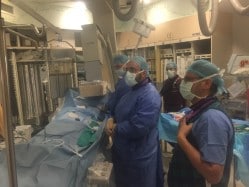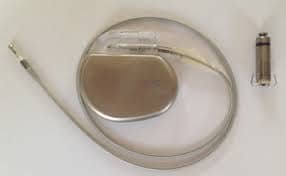Electrophysiology: Advanced Cardiac Devices for slow and fast heart rhythms
David Orenstein, FHRS, CEPS, CCDS
Cardiac Electrophysiology Technician, Hadassah Medical Center
With the increase in longevity and the stability of complicated patients with multiple illnesses, there are more and more patients who suffer from slow heart rate events (bradycardia) or who are at risk of dangerous fast heart rates (tachycardia). These patients require pacemakers to treat these slow heart rhythms or implanted defibrillators just in case they need to be treated including being shocked back into a normal rhythm. As we end up needing to treat older and more complex patient cases, we are faced with the requirement for new devices to improve our ability to safely care for these patients.
Until recently pacemakers and implantable defibrillators required an invasive surgical procedure. An incision is made in the skin, and electrodes are threaded through the veins into the heart. The electrodes are then attached to a device which sits noticeably under the skin in the chest area.
Complications of such procedures include accidental puncture of the lung or infection.
In complicated patients the placement of the pacemaker can be very difficult, and there is a higher risk of infection. Patients with diabetes, reduced kidney function, or previous procedures at the implantation site are at extremely high risk of infection or other complications. In some cases, technical challenges make implantation impossible, leaving open heart surgery as the only possible means of implanting electrodes into the heart.
At Hadassah, we have taken a leadership role in Israel and beyond, in the placement of two of the newest devices: the leadless pacemaker (Micra) and the sub-cutaneous implantable defibrillator (s-ICD).
- The leadless pacemaker is shown in this picture, in comparison to a standard pacemaker system.
The Micra is a tiny all-in-one device that contains both the controller and the pacing wire, which is implanted directly into the heart through a vein. An intravenous line is placed in the femoral vein in the leg. The Micra device is loaded onto a steerable catheter and then delivered through the vein directly into the heart, where it attaches itself in place. The entire procedure can take as little as 20 minutes. Once the IV in the leg is removed there is no scar, and there is a much lower risk of complications. Today we are the leading hospital in Israel in the implantation of the Micra leadless pacemaker.
- The sub-cutaneous (under-the-skin) implantable defibrillator (S-ICD) is another huge advance in the care of our patients.
This implantable defibrillator sits neatly under the skin in the arm pit area with a single electrode which is not placed into the heart but just sits above the heart under the skin. Despite the distance from the heart, the defibrillator is highly effective, and offers 24/7/365 detection and protection from dangerous fast heart rhythms. All this, without the need to introduce hardware into the body’s circulatory system or heart, thus minimizing the risk of serious infection. The device has all the latest algorithms, treating patients with life threatening arrhythmias.
The addition of these devices to our arsenal of treatments for heart rhythm problems is a significant step forward in our treatment of increasingly complicated patients.
Search
Recent Posts
Abuse and Heart Disease
Abuse and Heart Disease: Exposure to trauma and...The Fake News Fiasco
We are exposed to a tremendous amount of inform...Coaching For Change
The Pollin Center’s health coaching group is an...When on-line is off limits: Innovative Corona-tailored health promotion program for Ultra-orthodox women – Chevruta L’Chaim
Ultra-Orthodox (Haredi) women have worse health...21444
The stress, apprehension and the fears coupled ...


